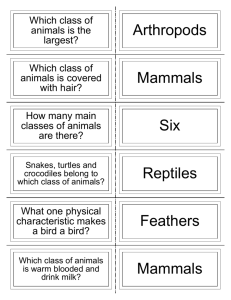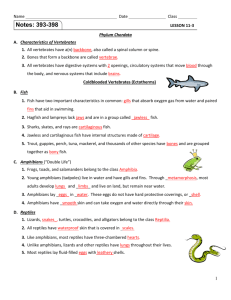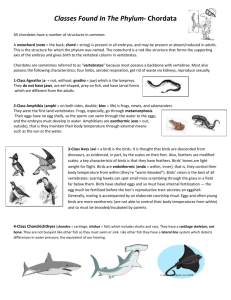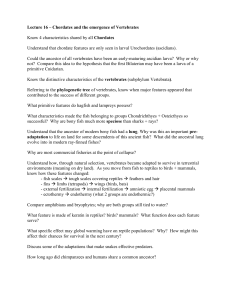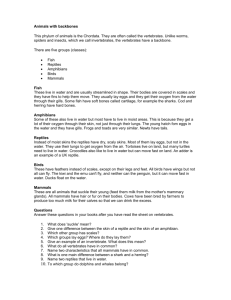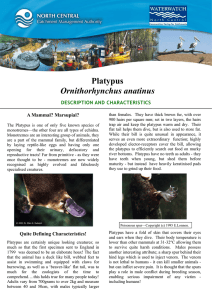Vertebrates - Qatar Academy
advertisement
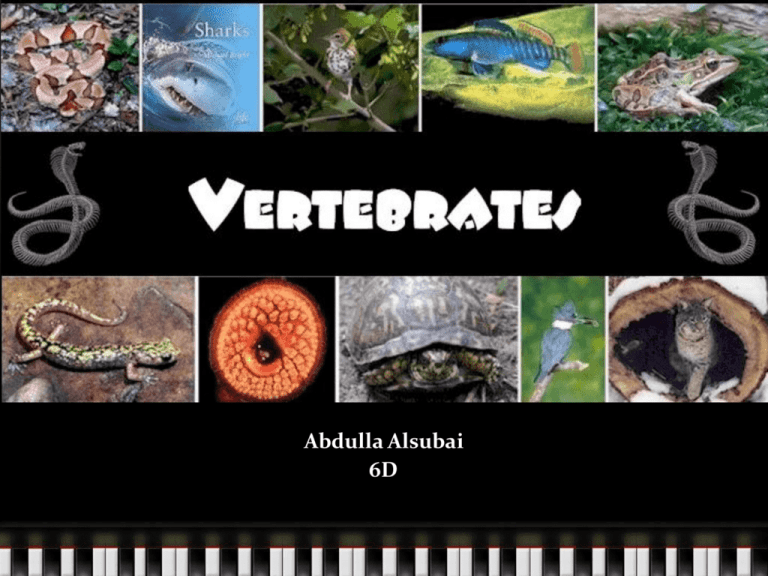
Vertebrates Abdulla Alsubai 6D Vertebrates Vertebrates are animals that have a backbone. Backbones are the bones that are located at the end of your back. Some examples of vertebrates are …fish, amphibians, reptiles, mammals, and birds. Invertebrates are spiders and insects because they don’t have a back bone. fish Gills for breathing Scales for protection Slimy skin fins Thousand of eggs Some fish can swim backwards. The diet of the flying fish mainly consists of small crustaceans and planktons. Stingrays use electric sensors to find food. This enables it to find its prey even if it is burried in the sand. The flying fish are attracted to light. This habit allows fishermen to catch them easily. At night many Parrotfish secrete and then sleep inside a mucous cocoon. This cocoon protects it from parastes and snails, also helps it warn about the presence of predators and adds a horrible taste and smell to the parrot fish thus keeping the predators at a safe distance. Some fish species are able to change their sex. Clown fish is a classic example of this, they are all born males and the dominant males change their sex during the course of life. Bettas breathe air. If they don't breathe air they will drown. Male betta fish builds a bubble nest for the arrival of eggs. The Salmon fish spends most of its time in the ocean but comes back to the freshwater for spawning. Oils from orange rough which is a deep-sea fish, are used in making shampoos. Amphibians Slimy skin Fish tale when young Four legs when adult Toad live in water Adults live on land Lay eggs in water Hundred or so eggs Amphibian facts What Makes an Amphibian? Amphibians are animals that live part of their lives in water and part on land. They usually have soft, moist skin that is protected by a slippery layer of mucus. They also tend to live in moist places or near water to keep their bodies from drying out. There are three main groups of amphibians: caecilians; salamanders, newts, and mudpuppies; and frogs and toads. Reptiles Dry leathery skin Small brains Several dozen of eggs Cold blooded Facts about Reptiles Reptiles are found in every continent except Antarctica. Reptiles have existed for more than 300 million years. There are more than 8000 reptile species in the world. Reptiles are lizards, snakes, turtles, and crocodiles as well as the lesser-known groups of tuataras. Reptiles have scales or horny plates that cover their body. You will often find reptiles lying in the sun on rocks and logs. They can rarely breath underwater. Reptiles are called cold-blooded because they can't regulate their own body temperature. Their body temperature is dependent on the external temperature. Most reptiles lay eggs which have leathery shells that are resistant to drying. Birds Feathers Beak besides teeth (they don’t chew) Dozen or so eggs Bird facts Birds have feathers, wings, lay eggs and are warm blooded. There are around 10000 different species of birds worldwide. The Ostrich is the largest bird in the world. It also lays the largest eggs and has the fastest maximum running speed (97 kph). Scientists believe that birds evolved from theropod dinosaurs. Birds have hollow bones which help them fly. Some bird species are intelligent enough to create and use tools. The chicken is the most common species of bird found in the world. Mammals Dry fur No eggs Milk provided for youngsters 4 limbs Facts about mammals Mammals are warm-blooded animals with hair on their bodies. They also give birth to live young. Well, most of them do, the duck billed platypus and 2 kinds of echidna are mammals but they lay eggs. Because the platypus and the echidna can do this they are called monotremes. What is an echidna? these are also known as Spiny Anteaters. There are all sorts of mammals in the world including kangaroos, dogs, gorillas, and cats. Even the mighty king of the sea, the blue whale, is really a mammal. Let’s discover some more facts about some unusual mammals. Platypus The Platypus has Eukaryotic cells with membrane bound organelles. The Platypus responds to stimuli and are multicelluar organisms The Platypus has a ventral nerve cord, pharyngeal slits and a tail. There are also three subphyla of Chordata, the Platypus belongs in the Vertebrata. The Platypus produces milk for the young through mammary glands like all mammals. It also is warm blooded and has three specialized bones in the ear for hearing, also it has no visible ears. A monotreme is simply a mammal that produces young by eggs instead of having live-birth. Platypuses Bibliography http://kids.sandiegozoo.org/animals/amphibians http://www.factsnfacts.com/living_beings_facts/marine_lif e_facts/fish/ • http://www.buzzle.com/articles/facts-about-reptiles.html • http://styledip.com/wp-content/uploads/2011/11/fish-2.jpg • http://crazyfrogss.com/wpcontent/uploads/2011/08/Amphibians.jpg Bibliography http://www.kidport.com/reflib/science/animals/Images/Li zard.JPG http://www.clipartlab.com/promo/mammals.gif http://www.thekidswindow.co.uk/News/Marvellous_Mam mals.htm http://www.dandare.org/FreeFun/Images/CartoonsMoviesTV/MonstersIn cForTheBirdsWallpaper1024.jpg Bibliography http://www.sciencekids.co.nz/sciencefacts/animals/bird.ht ml http://images.nationalgeographic.com/wpf/medialive/photos/000/006/cache/platypus_662_600x450.jpg

